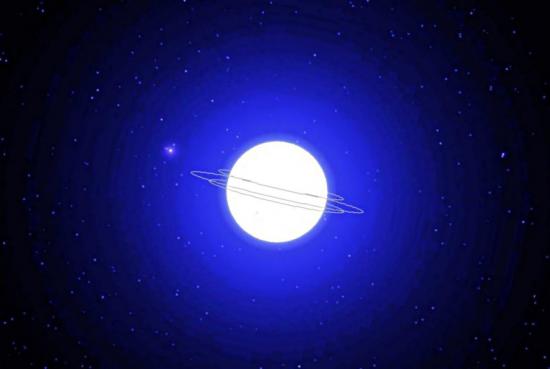BY LETTER
Adhara (Epsilon Canis Majoris)
 Image from Steve Bowers | |
| The energy collection systems around Adhara power the local transapient dataspheres | |
Adhara (Epsilon Canis Majoris) - Data Panel | |
| System | Names: Adhara Components: 2 1) Adhara (Epsilon Canis Majoris A) 2) Attaranmebat (Epsilon Canis Majoris B) Location: - Distance from Sol: 405 ly (J2000) - Constellation: Canis Major |
|---|---|
| Adhara | Names: Adhara, Epsilon Canis Majoris A, 21 Canis Majoris A, HD 52089 A, HIP 33579 A Physical characteristics: - Mass: 12.0 x Sol - Radius: 10.1 x Sol - Spectral type: B1.5 II - Luminosity: 22,400 x Sol (bolometric) - Temperature: 22,500 Kelvin - Rotation period: 24 days - Age: 14.6 million years |
| Companion | Attaranmebat, an A9.5 V star 964 AU away |
| Reached | 2808 AT |
Bright star in the Middle Regions, 405 light years from Sol, capital star of the Adhara Trade Treaty.
This star is a bright, hot star, emitting large amounts of ultraviolet light, and for observers who can detect UV it is the brightest star as seen from Sol. Adhara illuminates the dust and gas that forms the Local Bubble, a structure in interstellar space created by the explosion of Geminga 300,000 years ago. Adhara is (coincidentally) 405 light years from Geminga.
Five million years ago Adhara was much closer to Sol and was the brightest visual star in the skies of Pliocene Earth.
The Adhara Trade Treaty has two paraterraformed planets orbiting Attaranmebat (Bow and Arrow), which are far enough away from the primary to be safe from the ultraviolet emissions. Extensive power collection arrays around the primary collect a proportion of the invisible luminosity of this star and give power to the local Treaty archai.
Related Articles
Appears in Topics
Development Notes
Text by Steve Bowers
Initially published on 30 July 2009.
- Adhara's rotation period is only constrained to be between 1.3 and 24 days - the latter is used.
- Epsilon Canis Majoris B's spectral type is obtained from comparing Gaia temperature with Eric Mamajek's "A Modern Mean Dwarf Stellar Color and Effective Temperature Sequence" table.
Initially published on 30 July 2009.
- Adhara's rotation period is only constrained to be between 1.3 and 24 days - the latter is used.
- Epsilon Canis Majoris B's spectral type is obtained from comparing Gaia temperature with Eric Mamajek's "A Modern Mean Dwarf Stellar Color and Effective Temperature Sequence" table.






